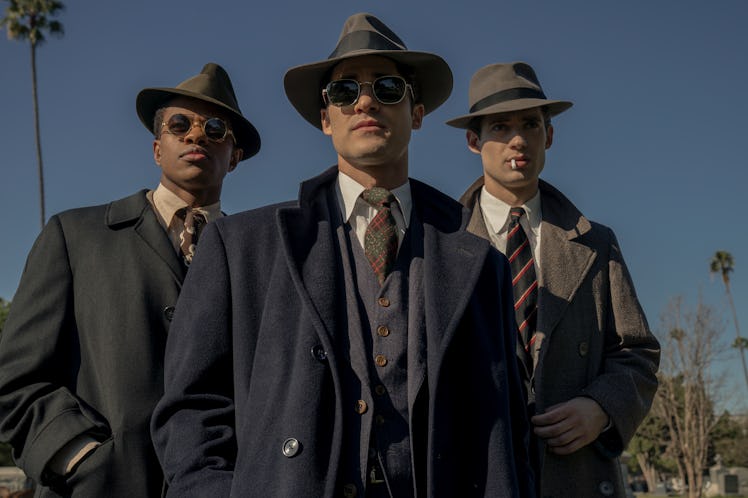
Let's Break Down All The IRL Events In Netflix's 'Hollywood'
Hollywood is the brand new series from Ryan Murphy, a period piece set in 1947 Los Angeles in the waning days of the studio system. The story is a fantasy, a Hollywood-that-could-have-been. In it, the fictional Ace Studios, under the direction of studio head Ace's wife Avis, greenlights a movie based on the life of Peg Entwistle, but with a twist. The leading role is played by an African-American actress, something unheard of as the time, and her love interest is white, creating the first interracial onscreen couple. But even so, fans are wondering, how real is Netflix's Hollywood? Despite the story being a fantasy, there are cameos from real people left and right. Warning: Spoilers for Hollywood follow.
But perhaps the biggest question is if the script for Peg (which becomes Meg) is based on a real story. It is.
Peg Entwistle was a British stage actress, who worked on Broadway for several years, mostly in comedic roles, before attempting to transfer to Hollywood. She did poorly there, only making one film, Thirteen Women. Not all 13 women made it into the film's final cut, but, despite the script saying she was one of them, Entwistle was not one of those left out. Even so, she committed suicide before her film was released, throwing herself off the H of the famous "Hollywoodland" sign.
As for the other significant details:
01Contract Players
Hollywood is carefully timed to that it occurs in 1947, one year before the paramount decision by the Supreme Court ended what was known as the "studio system." That means everything the show says about the way things work is true. Extras stand outside hoping for walk-ons, bit parts hope for contracts, those on contract are the ones allowed to try for roles, etc.
02Anna May Wong
Michelle Krusiec plays Anna May Wong, a real-life figure who was the first Chinese American Hollywood movie star. Everything about her refusing to be considered for The Good Earth is true, including the casting of white actress Luise Rainer.
What the show does not mention is Wong will go on to make history with The Gallery of Madame Liu-Tsong, the first-ever U.S TV series starring an Asian-American lead in 1951.
03Rock Hudson
Rock Hudson is known today for being the celebrity that brought awareness of AIDS to mainstream America when he died of it in 1985. (It was also, for many, the first time they learned he was gay.)
The early beginnings of Hudson's career in the series are mostly correct (save the relationship with Archie). He was a young midwestern boy who signed with Henry Willson in the late 1940s. Willson was the one who changed his charge's name from Roy Scherer to Rock Hudson. He was also said to be terrible in his first onscreen role in 1948, where the story goes it took 38 takes for him to deliver his only line in the film.
Though parts of his story are unconfirmed, his mother did remarry a marine officer when her son was still young, and Hudson was said to have despised his stepfather.
04Henry Willson
As for Henry Willson, another real-life figure, Hudson wasn't his only success story. Willson is credited for starting the entire 1950s "beefcake" craze in male movie stars, with a whole stable of Hudson-types.
As for his behavior, a lot of that is conjecture, but it is known he struggled with alcoholism, drugs, and weight problems later in life, and he died of cirrhosis of the liver in 1978, having been outed as gay in the Hollywood community, who proceeded to shun him out of fear of being branded the same.
05Vivien Leigh
Vivien Leigh gets a pair of cameo appearances in the series first at Cukor's party, and then at the Oscars later on. A lot of the details are dead on. Leigh was bipolar, and her "incidents" (and her resulting "difficult to work with" reputation) were legendary. Also, the timing of her going to the West End to star in A Streetcar Named Desire is correct. She would go on to star in the movie version as well.
06Hattie McDaniel
The Hattie McDaniel details in Hollywood are also a pretty spot on. The year she broke the color barrier by winning the Academy Award for Best Supporting Actress for Gone With The Wind, the ceremony was held at the Ambassador Hotel, a segregated establishment.
The bit in the Netflix series about her being made to wait outside is wrong. According to Hollywood historians, she was given a table in the back corner and then moved up when they found out she was going to take the win.
But the rest is all true, according to reports. She did dedicate her performance to her grandmother, who spent her life a slave.
07The 1948 Oscars
One would think Hollywood's fantasy Oscars, where Meg wins nearly all the trophies, would be made up. All of the other nominees named during the 1948 Oscar ceremony were actual nominees that year. Meg's one significant loss is to Edmund Gwenn, who did win for his role as Kris Kringle in Miracle on 34th Street. (It was a historic win too, he was the oldest person ever to win an Oscar at the time.)
Notably, what the show leaves out is this was the year the first African-American man won a statuette. James Baskett received an Academy Honorary Award for his portrayal of Uncle Remus in Song of the South.